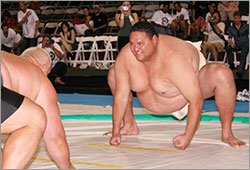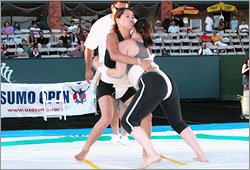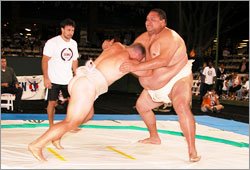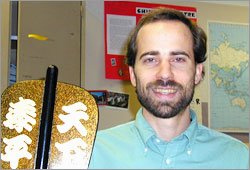YuYu interview Andrew Freund
 |
| —— How did you first get interested in sumo? Well it all started while I was living in Japan. I was living in Ichikawa and spent a lot of tie on the trains commuting to work. I wasn’t very outgoing and didn’t really didn’t do too much, but toward the end of my stay in Japan, I started thinking about doing something to remember my time there̶ something Japanese. So I picked up a copy of the “Tokyo Journal” and began looking for different things to do around Tokyo. I tried a few of the day-hikes and then I saw the ad for sumo. Ryogoku wasn’t too far, so I decided to go. The stated time was from 9-6PM, so without knowing any better, I showed up at 9AM, bought my ticket and went in. No one really shows up for the early matches so from around 9:30 to 3 there I was, sitting all by myself, far from the ring in my designated seat, even though there couldn’t have been more that a couple dozen people there. I sat there for hours, watching the same things over and over again... all by myself, wondering what am I doing here. Finally, in the last hour or two, people started showing up and the major matches took place. That was my very first sumo experience... my introduction. I had studied other forms of martial arts and had an interest in Japanese culture, but before that day I never really had any particular interest in sumo. I remember thinking I’ll bet I could do that... little did I know what the future had in store! —— Are there many differences between the sumo here and Japanese sumo?  Well first of all the CSA is amateur sumo, not professional, so we follow the standards of the International Sumo Federation, so it’s a little different than the Nihon Sumo Kyokai. For amateur sumo to become an Olympic sport there had to be international standards and so they established weight classes: light, middle and heavyweight, for both men and women, which is different than Japanese Professional sumo. Rules and clothing requirements are also slightly different, for example you are allowed to wear tights under your “mawashi” if you choose to and there is no slapping to the face. Basically the rules are the same however there is a condensed ritual, though not completely eliminated. Outside the dohyo there is the bow, which is standard, we don’t do the “shiko”, we step in the ring and come forward into position and squat in front of the other wrestler, the referee will then give the command “mattanashi”, no more waiting, then the wrestlers will get into final position with both hands on the floor out in front and the referee will give the command “hakioi” which starts the match, which is only slightly different than Japanese matches. Well first of all the CSA is amateur sumo, not professional, so we follow the standards of the International Sumo Federation, so it’s a little different than the Nihon Sumo Kyokai. For amateur sumo to become an Olympic sport there had to be international standards and so they established weight classes: light, middle and heavyweight, for both men and women, which is different than Japanese Professional sumo. Rules and clothing requirements are also slightly different, for example you are allowed to wear tights under your “mawashi” if you choose to and there is no slapping to the face. Basically the rules are the same however there is a condensed ritual, though not completely eliminated. Outside the dohyo there is the bow, which is standard, we don’t do the “shiko”, we step in the ring and come forward into position and squat in front of the other wrestler, the referee will then give the command “mattanashi”, no more waiting, then the wrestlers will get into final position with both hands on the floor out in front and the referee will give the command “hakioi” which starts the match, which is only slightly different than Japanese matches.Culturally the idea of sumo is different. In Japan sumo is not just a sport, it’s much more than that... it’s cultural! It’s the blending of so many things, of martial arts, history, ritual and tradition. Outside Japan there is more of the idea of sumo as a sport rather than a tradition. Whereas pro sumo in Japan dedicate their whole lives, all day every day, to their craft, for most amateurs outside of Japan it is more of a hobby... something for weekend warriors to try, along with their other activities. Very few people would ever want to become a pro sumo and live in that very restrictive world and fewer still ever get the opportunity. The obstacles are almost insurmountable and that’s why so few people have ever done it. —— Do you have to overcome a lot of misconceptions about sumo? 
Akebono squares off against US Sumo Open champion Barnabas Toth. Photo by Chieko Hayashi.
To be a great sumo wrestler requires quickness, strength and flexibility. Some of the top guys like Chiyonofuji have 50m and 100m times that are right up there with many competitive sprinters and their strength is off the chart, not to mention their flexibility. Just about every sumo can do a full split! Only gymnasts have the strength and flexibility of a sumo. Their combination of strength flexibility and quickness is almost unparalleled! —— How did your group, the California Sumo Association, get started? It wasn’t until I moved back to the states that I started to develop more of a serious interest. I had come back and taken a job in LA teaching and one day a student of mine gave me a couple of tickets to the Japan Expo downtown. So I called a friend, who had also been to Japan, and we went to check it out for old times sake. Well, among other things there was a sumo demonstration. We were watching and really getting into it and then they asked if anyone wanted to try. I kept pushing my friend to try, since he’s a pretty big guy, and he finally said, “I’ll do it if you do it!” So we both tried and it was pretty cool! From there we decided, along with some of our friends, to form a little sumo club. It was a great workout and people really liked the idea of sumo because it’s so “hands-on”. It started out here at UCLA and eventually we started offering classes through the UCLA recreation programs around ‘98. —— How did you go from a small club to hosting an international tournament, the U.S. Sumo Open? 
Female sumo dig in at the US Sumo Open. Photo by Chieko Hayashi
—— I understand you’ve had some sumo celebrities make appearances at the U.S. Sumo Open, can you tell me what that was like? It was great! We’ve been fortunate to welcome some sumo legends like Konishiki and Akebono here and that has been outstanding. Both of them love the sport and were very open to the idea to come out and promote it. Still there were times when I didn’t think either one was going to be able to make it here for one reason or another. That could have been disastrous, especially after we had already printed materials and scheduled media appearances, but in the end everything worked out wonderfully. They’re both great guys, warm, outgoing, but couldn’t really show that side of their personalities while they were in Japan. There they always had to be much more guarded about everything they said and did and so they felt very much at ease here. I don’t think Konishiki had the patience to live in that kind of rigid, traditional atmosphere of the sumo world, especially after spending some time with him. However, when we interviewed Akebono he expressed that he was prepared to remain an “Oyakata” to help the sport of sumo grow. He thought he could do a lot from the inside, especially working with some of the other younger champions like Takanohana, but now evidently he’s had a change of heart. —— Are there any memorable moments that stand out over the history of the U.S. Sumo Open? 
Akebono towers over Hawaiian amateur champion, Kena Heffernan, as referee, two-time amateur world champion, Svetoslav Binev looks on.Photo by Chieko Hayashi.
—— What does the CSA do when you’re not preparing for the U.S. Sumo Open?  Well we hold smaller competitions throughout the year, as well as putting on demonstrations at various places throughout California to promote the sport. We usually hold weekly practices open to members or anyone who wants to participate. The size of the classes varies anywhere from 7- 20 depending on the time of the year. We want to show it as a sport, requiring speed, strength and flexibility and at the same time we’d like people to understand some of the cultural aspects of it, which are important to any martial art. I at least want people to know and understand the “shiko”, the stretching and stomping warm-up, done before each practice and match. So we’ve incorporated some of the showmanship, cultural, and sport aspects of sumo, so it’s really quite fascinating on different levels. We want people to recognize that this is an athletic sport. Well we hold smaller competitions throughout the year, as well as putting on demonstrations at various places throughout California to promote the sport. We usually hold weekly practices open to members or anyone who wants to participate. The size of the classes varies anywhere from 7- 20 depending on the time of the year. We want to show it as a sport, requiring speed, strength and flexibility and at the same time we’d like people to understand some of the cultural aspects of it, which are important to any martial art. I at least want people to know and understand the “shiko”, the stretching and stomping warm-up, done before each practice and match. So we’ve incorporated some of the showmanship, cultural, and sport aspects of sumo, so it’s really quite fascinating on different levels. We want people to recognize that this is an athletic sport.—— For example, if I were just starting off, what would I be doing my first day? Well I’ll tell you what Svet, our coach, would have you do. First you’d get into your “mawashii”, then he’d start everyone off with some basic stretching for 20-30 minutes, the same as you’d do for any martial art or sport. This is necessary for the correct postures and to prevent injuries, then we’d do some different footwork and agility exercises, then we’d work on quickness drills, some 20-30m sprints, and some jumps to develop explosive power. Then we might practice the “shiko”, which could be part of the stretching, and we’d like everybody to be able to squat for a starting posture. From there we might practice the rituals of clapping and spreading our arms and showing our palms to show we don’t have any weapons. We wouldn’t work on all 80 techniques like they would in Japan, just the basics, such as pushing or moving your arms as fast as you can without any grips, practicing staying low and keeping a low center of gravity, and keeping your elbows in. In sumo there is really something for everybody because the basics are accessible to just about everyone, however for people who want to go further there is a depth and a richness left to uncover. People always have fun when they come out, no matter what level they’re at or what shape they’re in. (01-16-2004 issue, Interviewed by Terry Nicholas) |

